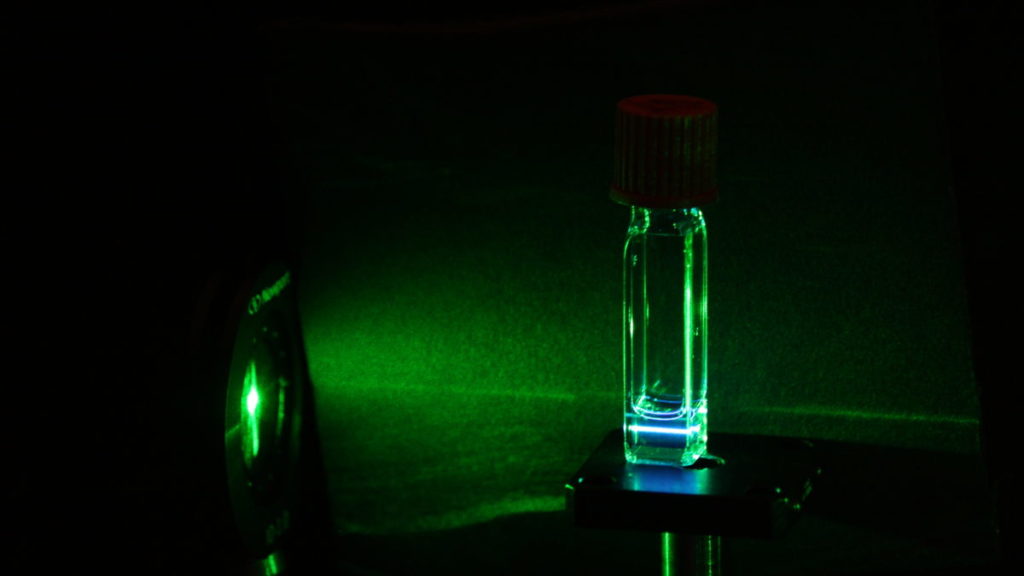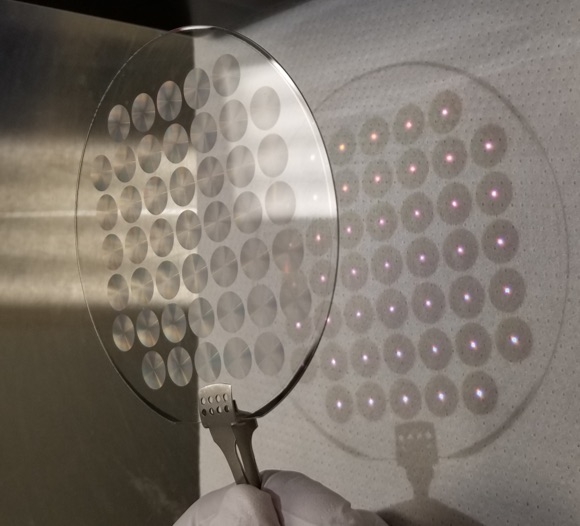(Researchers Discover New Way to Split and Sum Photons with Silicon)
2019/12/2 テキサス大学オースチン校(UT Austin)

・ UT Austin とカリフォルニア大学リバーサイド校(UCR)が、新たに開発したハイブリッド材料のシリコンとアントラセンの有機炭素分子間でエネルギー移動を可能にする方法を発見。
・長らく仮説とされてきたこのようなエネルギー移動の現象は、量子コンピューティングや太陽エネルギー変換、医療用イメージングに影響を及ぼす。
・コンピューターや太陽光パネルで使用されるシリコンは、赤色のフォトン(光子)を電気に変換できるが、その2倍のエネルギーを有する青色のフォトンでは不可能。そのエネルギーのほとんどを熱として損失してしまう。
・ シリコンと炭素ベース材料のアントラセンを組合せた同新ハイブリッド材料は、シリコンがより効率的に利用できる赤色フォトン 2 個へと青色フォトンを変換し、シリコンの効率性向上の手段を提供。シリコンとアントラセンの化学結合で両材料間に分子のワイヤが構築され、異なる波長の光にも反応するよう微調整できるため、青色フォトン 1 個から赤色フォトン 2 個に変換、またその逆変換も可能となる。
・ これまで、青色・緑色光を効率的に吸収するある種の有機材料とシリコンを組合せることで、シリコンによる光から電気への変換能力の向上が期待されてきた。「スピン-三重項励起子移動」と呼ばれる、炭素ベース材料からシリコンへのエネルギー移動は、両材料を単に重ね合わせるだけでは発生しない。
・ 今回、シリコンナノ結晶とアントラセンを結合する微細なワイヤによる新たな化学的インターフェースを作ることで、仮説とされていた両物質間でのエネルギー移動に初めて成功した。
・ シリコンとアントラセンを繋ぐこのような分子のワイヤは、高速、高効率で復元力に富む。約 90%のエネルギーをシリコンから有機分子へ効果的に移動させることを超高速レーザーを用いて確認。
・ この技術により、多様な色の光を吸収・放出できる材料の作製が可能に。微調整することで、バッテリー不要の暗視ゴーグルや小型エレクトロニクス等の多様なアプリケーションの創出も可能。
・ このような「フォトン・アップコンバージョン」のプロセスは、これまで毒性のある材料に頼っていたが、今回のアプローチでは無毒性の材料のみを使用。医療分野や環境分野でのアプリケーションの可能性が拓く。
・ 本研究には、米国立科学財団(NSF)、Robert A. Welch 財団、Research Corporation for Science
Advancement および米国空軍科学研究局(AFOSR)が資金を提供した。
https://news.utexas.edu/2019/12/02/researchers–discover–new–way–to–split–and–sum–
(関連情報)
Nature Chemistry 掲載論文(アブストラクトのみ:全文は有料)
Achieving spin-triplet exciton transfer between silicon and molecular acceptors for photon upconversion
URL: https://www.nature.com/articles/s41557-019-0385-8
<NEDO海外技術情報より>
Abstract
Inorganic semiconductor nanocrystals interfaced with spin-triplet exciton-accepting organic molecules have emerged as promising materials for converting incoherent long-wavelength light into the visible range. However, these materials to date have made exclusive use of nanocrystals containing toxic elements, precluding their use in biological or environmentally sensitive applications. Here, we address this challenge by chemically functionalizing non-toxic silicon nanocrystals with triplet-accepting anthracene ligands. Photoexciting these structures drives spin-triplet exciton transfer from silicon to anthracene through a single 15 ns Dexter energy transfer step with a nearly 50% yield. When paired with 9,10-diphenylanthracene emitters, these particles readily upconvert 488–640 nm photons to 425 nm violet light with efficiencies as high as 7 ± 0.9% and can be readily incorporated into aqueous micelles for biological use. Our demonstration of spin-triplet exciton transfer from silicon to molecular triplet acceptors can critically enable new technologies for solar energy conversion, quantum information and near-infrared driven photocatalysis.



